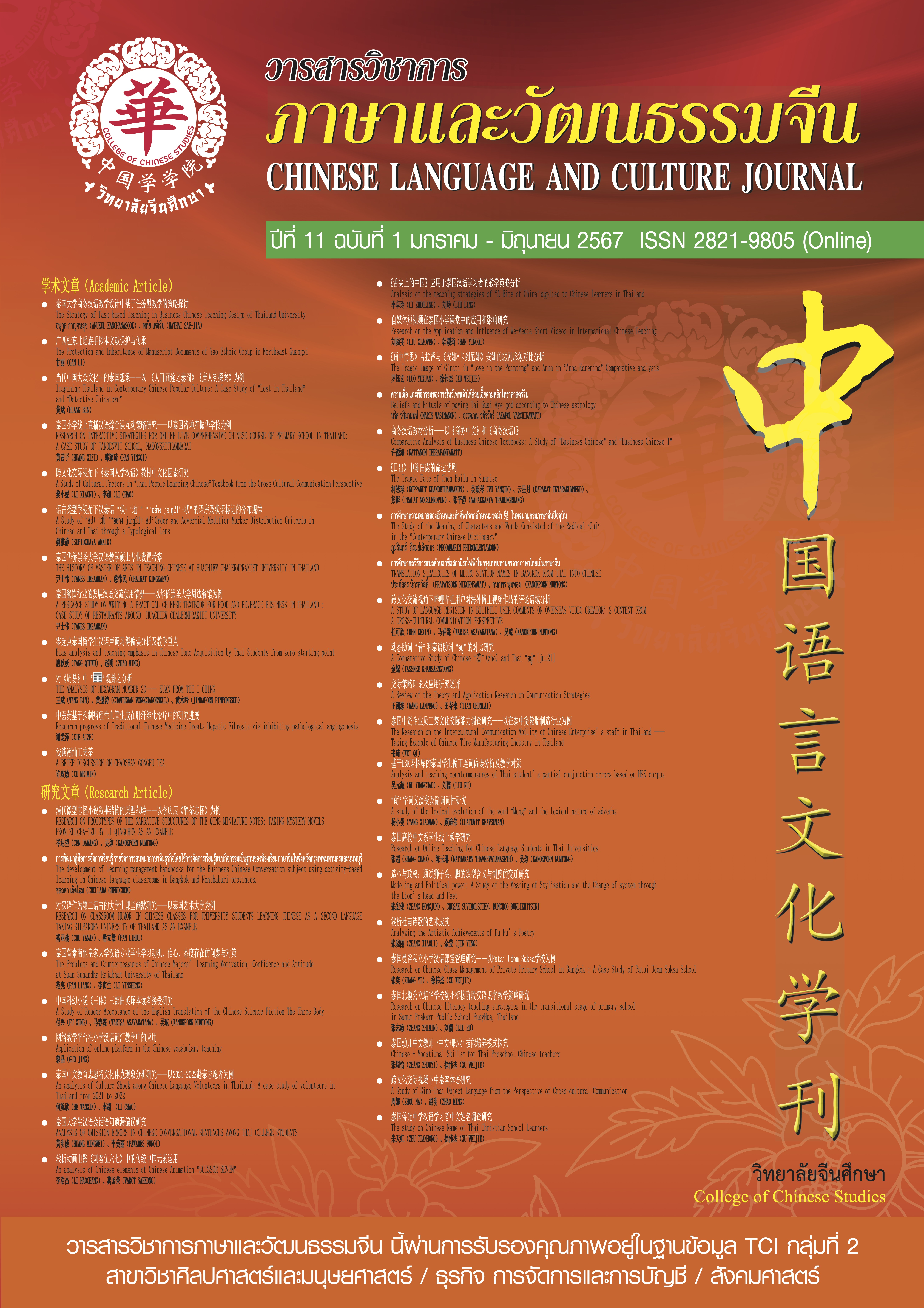Bias analysis and teaching emphasis in Chinese Tone Acquisition by Thai Students from zero starting point
Keywords:
Thai students, Chinese tones, acquisition errors, teaching focusAbstract
As is well known, Chinese is a tonal language. The acquisition of Chinese phonetics serves as the foundation for learning Chinese as a second language. Tonal distinctions in Chinese carry significant semantic differences, making the acquisition of Chinese tones a focal point and challenge in learning Chinese phonetics. Although Thai, like Chinese, is also a tonal language, the tone values in these two languages are not entirely the same. For Thai students, whose mother tongue is a tonal language, they need to relearn a set of pitch patterns different from their native tone system when acquiring Chinese tones, inevitably leading to pronunciation errors. For Thai students, failure to acquire Chinese tones accurately will result in the issue of "Thai accent in Chinese." This article, based on previous research findings, combines the author's years of experience in teaching Chinese as a foreign language and research on Thai phonetics. It utilizes methods such as literature analysis, comparative analysis, experiential summary, and experimental research. Taking Thai students at the elementary level as the research subjects, it analyzes the similarities and differences between Chinese and Thai tones in terms of tone values and tone categories. It applies error analysis theory to identify the main pronunciation errors that Thai students encounter when learning Chinese tones. Finally, based on the identified focal points and challenges, it proposes some key aspects in teaching Chinese tones.
References
陈孝锋,侯孟妤.汉、泰声调对比及泰汉语声调教学[J].赤峰学院学报汉文哲学社会科学版),2016,37(04):267-269.
丁海娟,纪晓丽.近三十年汉语学习者汉语声调习得研究综述[J].海外英语2020,(11):227-228+230.
冯 丽.初级泰国留学生汉语语音学习的偏误分析[J].文学界(理论版),2012,(03):95-96.
傅海峰.“零起点”声调教学刍议[J].辽宁经济管理干部学院学报,2009,(02):100-101.
黄伯荣, 廖序东.现代汉语[M].北京:高等教育出版社, 2007.
李红印.泰国学生汉语学习的语音偏误[J].世界汉语教学,1995,(02):66-71.
刘 珣.对外汉语教学引论[M].北京:北京语言文化大学出版社,2007.
刘 洋.对外汉语教学中的声调偏误分析及教学方法探讨[J].教育教学论坛,2016,(32):271-272.
毛 丽.声调偏误与对外汉语声调教学研究综述[J].湖南第一师范学报,2007(02):119-122.
潘 漪.泰国初级汉语水平学习者的汉语声调习得与教学研究[硕士学位论文].[D].江苏省:江苏师范大学,2018.
任 静.关于对外汉语声调教学的思考[J].西部素质教育,2018,4(05):166-167.
沈晓楠.关于美国人学习汉语声调.世界汉语教学, 1989(03), 158-168.
宋益丹.对外汉语声调教学策略探索[J].语言教学与研究,2009(03):48-53.
王安红.汉语声调特征教学探讨[J].语言教学与研究,2006(03):70-75.
熊宁利.初级阶段留学生汉语语音习得偏误分析与教学策略[J].河南科技学院学报,2019,39(06):57-62.
许艳艳.泰国人学汉语的语音难点及教学策略[J].广西师范学院学报(哲学社会科学版),2009,30(03):139-142.
张婷,彭青.汉语和泰语声调对比研究及对泰声调教学建议[J].兰州交通大学学报,2021,40(04):064-172.
赵元任.赵元任语言学论文选.北京:中国社会科学出版社.1985
H.Henny Yeung,Ke Heng Chen,Janet F. Werker.(2013) When does native language input affect phonetic perception? The precocious case of lexical tone. Journal of Memory and Language 68:2, 123-139.
http://www.sina.com.cn.新浪教育.(2002.11.21).[引用日期2023-3-11]
Downloads
Published
How to Cite
Issue
Section
License
Copyright (c) 2024 Chinese Language and Culture Journal

This work is licensed under a Creative Commons Attribution-NonCommercial-NoDerivatives 4.0 International License.
บทความที่ได้รับการตีพิมพ์เป็นลิขสิทธิ์ของวารสารภาษาและวัฒนธรรมจีน มหาวิทยาลัยหัวเฉียวเฉลิมพระเกียรติ
บทความใน “วารสารวิชาการภาษาและวัฒนธรรมจีน” เป็นทรรศนะของผู้เขียนโดยเฉพาะ กองบรรณาธิการไม่มีส่วนในความคิดเห็นในข้อเขียนเหล่านั้น




